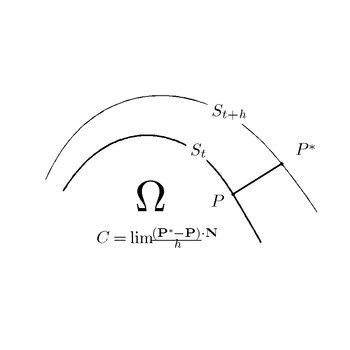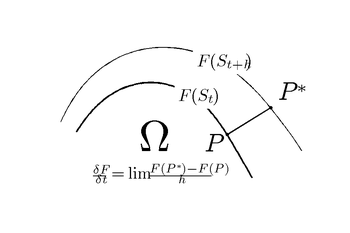Calculus of moving surfaces

The calculus of moving surfaces (CMS) [1] is an extension of the classical tensor calculus to deforming manifolds. Central to the CMS is the  -derivative whose original definition [2] was put forth by Jacques Hadamard. It plays the role analogous to that of the covariant derivative
-derivative whose original definition [2] was put forth by Jacques Hadamard. It plays the role analogous to that of the covariant derivative  on differential manifolds. In particular, it has the property that it produces a tensor when applied to a tensor.
on differential manifolds. In particular, it has the property that it produces a tensor when applied to a tensor.

Suppose that  is the evolution of the surface
is the evolution of the surface  indexed by a time-like parameter
indexed by a time-like parameter  . The definitions of the surface velocity
. The definitions of the surface velocity  and the operator
and the operator  are the geometric foundations of the CMS. The velocity C is the rate of deformation of the surface
are the geometric foundations of the CMS. The velocity C is the rate of deformation of the surface  in the instantaneous normal direction. The value of
in the instantaneous normal direction. The value of  at a point
at a point  is defined as the limit
is defined as the limit
where  is the point on
is the point on  that lies on the straight line perpendicular to
that lies on the straight line perpendicular to  at point P. This definition is illustrated in the first geometric figure below. The velocity
at point P. This definition is illustrated in the first geometric figure below. The velocity  is a signed quantity: it is positive when
is a signed quantity: it is positive when  points in the direction of the chosen normal, and negative otherwise. The relationship between
points in the direction of the chosen normal, and negative otherwise. The relationship between  and
and  is analogous to the relationship between location and velocity in elementary calculus: knowing either quantity allows one to construct the other by differentiation or integration.
is analogous to the relationship between location and velocity in elementary calculus: knowing either quantity allows one to construct the other by differentiation or integration.


 -derivative of an invariant field F
-derivative of an invariant field FThe  -derivative for a scalar field F defined on
-derivative for a scalar field F defined on  is the rate of change in
is the rate of change in  in the instantaneously normal direction:
in the instantaneously normal direction:
This definition is also illustrated in second geometric figure.
The above definitions are geometric. In analytical settings, direct application of these definitions may not be possible. The CMS gives analytical definitions of C and  in terms of elementary operations from calculus and differential geometry.
in terms of elementary operations from calculus and differential geometry.
Analytical definitions
For analytical definitions of  and
and  , consider the evolution of
, consider the evolution of  given by
given by
where  are general curvilinear space coordinates and
are general curvilinear space coordinates and  are the surface coordinates. By convention, tensor indices of function arguments are dropped. Thus the above equations contains
are the surface coordinates. By convention, tensor indices of function arguments are dropped. Thus the above equations contains  rather than
rather than  .The velocity object
.The velocity object
 is defined as the partial derivative
is defined as the partial derivative
The velocity  can be computed most directly by the formula
can be computed most directly by the formula
where  are the covariant components of the normal vector
are the covariant components of the normal vector  .
.
The definition of the  -derivative for an invariant F reads
-derivative for an invariant F reads
where  is the shift tensor and
is the shift tensor and
 is the covariant derivative on S.
is the covariant derivative on S.
For tensors, an appropriate generalization is needed. The proper definition for a representative tensor  reads
reads
where  are Christoffel symbols.
are Christoffel symbols.
Properties of the δ/δt-derivative
The  -derivative commutes with contraction, satisfies the product rule for any collection of indices
-derivative commutes with contraction, satisfies the product rule for any collection of indices
and obeys a chain rule for surface restrictions of spatial tensors:
Chain rule shows that the  -derivative of spatial "metrics"
vanishes
-derivative of spatial "metrics"
vanishes
where
 and
and  are covariant and contravariant metric tensors,
are covariant and contravariant metric tensors,  is the Kronecker delta symbol, and
is the Kronecker delta symbol, and  and
and  are the Levi-Civita symbols. The main article on Levi-Civita symbols describes them for Cartesian coordinate systems. The preceding rule is valid in general coordinates, where the definition of the Levi-Civita symbols must include the square root of the determinant of the covariant metric tensor
are the Levi-Civita symbols. The main article on Levi-Civita symbols describes them for Cartesian coordinate systems. The preceding rule is valid in general coordinates, where the definition of the Levi-Civita symbols must include the square root of the determinant of the covariant metric tensor
 .
.
Differentiation table for the δ/δt-derivative
The  -derivative of the key surface objects leads to highly concise and attractive formulas. When applied to the covariant surface metric tensor
-derivative of the key surface objects leads to highly concise and attractive formulas. When applied to the covariant surface metric tensor  and the contravariant metric tensor
and the contravariant metric tensor
 , the following identities result
, the following identities result
where  and
and  are the doubly covariant and doubly contravariant curvature tensors. These curvature tensors, as well as for the mixed curvature tensor
are the doubly covariant and doubly contravariant curvature tensors. These curvature tensors, as well as for the mixed curvature tensor  , satisfy
, satisfy
The shift tensor  and the normal
and the normal
 satisfy
satisfy
Finally, the surface Levi-Civita symbols  and
and  satisfy
satisfy
Time differentiation of integrals
The CMS provides rules for time differentiation of volume and surface integrals.
References
- ↑ Grinfeld, P. (2010). "Hamiltonian Dynamic Equations for Fluid Films". Studies in Applied Mathematics. doi:10.1111/j.1467-9590.2010.00485.x. ISSN 00222526.
- ↑ J. Hadamard, Lecons Sur La Propagation Des Ondes et Les Equations De l’Hydrodynamique. Paris: Hermann, 1903.










![\begin{align}
\frac{\delta S_{\alpha \beta }}{\delta t} & = -2CB_{\alpha \beta } \\[8pt]
\frac{\delta S^{\alpha \beta }}{\delta t} & = 2CB^{\alpha \beta }
\end{align}](../I/m/966059db9c34d0ee1fd5646d0dce60ac.png)
![\begin{align}
\frac{\delta B_{\alpha \beta }}{\delta t}& = \nabla _\alpha \nabla_\beta C - CB_{\alpha \gamma }B^\gamma_\beta \\[8pt]
\frac{\delta B^\alpha_\beta}{\delta t}& = \nabla^\alpha \nabla_\beta C + CB^\alpha_\gamma B^\gamma_\beta \\[8pt]
\frac{\delta B^{\alpha \beta }}{\delta t}& = \nabla ^\alpha \nabla^\beta C + 3CB^\alpha_\gamma B^{\gamma \beta}
\end{align}](../I/m/c0627d73df9dc38af2c02a54d3c16d46.png)
![\begin{align}
\frac{\delta Z^i_\alpha}{\delta t} & = \nabla _\alpha \left( CN^i \right) \\[8pt]
\frac{\delta N^i}{\delta t} & = -Z^i_\alpha \nabla^\alpha C
\end{align}](../I/m/8daafb24a31805fc8253529f2f2f8f74.png)
![\begin{align}
\frac{\delta \varepsilon _{\alpha \beta }}{\delta t} & = -\varepsilon _{\alpha \beta }CB^{\gamma }_{\gamma } \\[8pt]
\frac{\delta \varepsilon ^{\alpha \beta }}{\delta t} & = \varepsilon ^{\alpha \beta }CB^\gamma_\gamma
\end{align}](../I/m/f267b5ea57509755d8d3e2c9744d8bb1.png)